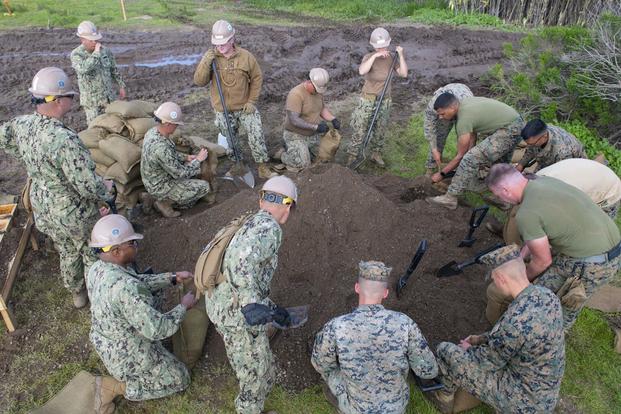Members of I Marine Expeditionary Force taking part in Pacific Blitz 2019 may find themselves helping the Navy attack enemy ships with long-range precision fires from shore positions.
About 5,000 Marines from I MEF joined approximately 5,000 sailors operating on four ships from the Navy's 3rd Fleet on March 12 for the large-scale, joint exercise off the coast of Southern California. It runs until March 26.
For the Marines, some of the focus of the exercise will be on "how are we doing naval integration in such a way that we can contribute to the sea control fight that the Navy would be prosecuting" against a near-peer adversary such as China or Russia, Lt. Gen. Joseph Osterman, commander of I MEF, told defense reporters Friday.
"Some of [what] we are looking at is ... by putting a landing force ashore, for example, how would that landing force project fires, both kinetic and non-kinetic, to help achieve sea control?" he said.
This could be made possible using developmental missile technology designed to be retrofitted onto the high mobility artillery rocket system, or HIMARS, Osterman said.
"We would be able to ... project things like that ashore to be able to conduct anti-surface fires from the shore," he said.
Marines might also act as forward observers from shore, using high-tech sensors on unmanned aerial systems to target enemy ships for naval fires.
"Maybe the force that's ashore is actually doing the target acquisition and target identification through electronic means or visual means. Or let's say a UAS operating from the shore then cues a naval shooter that is over the horizon," Osterman said. "This would allow, from a sea control perspective, for the ground forces to actually be woven in … That we could help contribute to."
It has been about two years since I MEF participated in such a large-scale exercise, but the Marine Corps is trying to get back to having a MEF-level exercise every year, he said.
"For me, it's not so much about end-states achieved as much as it is the exercise kind of giving us somewhat of a journey," Osterman said. " ... Really, kind of almost a shifting from what we have been used to doing in terms of a counterterrorism ... environment in Iraq and Afghanistan and ... getting more toward the near-peer fight."
Marine aviation assets such as the MV-22 Osprey and CH-53 helicopters will focus on conducting refueling operations at forward arming and refueling points, or FARPs, during Pacific Blitz.
"We are working with them in terms of being able to conduct FARP operations with the MV-22s, the CH-53s and then even to the point of bringing in high-capacity [fuel] bladders and things like that to refuel from remote locations, a little more extensive than we have done in the past with a typical raid operation," Osterman said.
The exercise will also give I MEF a chance to test new concepts and procedures aimed at refining its UAS strategy.
I MEF's leadership will spend a lot of time during Pacific Blitz working with leaders from the 3rd Fleet on how to enhance and streamline joint decision-making, he said.
"When we go into a near-peer fight, you would end up with a situation whereby the enemy has probably got very similar capability, very similar capacity and very similar lethality. So you have to ask yourself, where is your tactical edge? Where can you basically get ahead of the enemy?" Osterman said. "In my mind, that is in the decision space."
If a joint Marine-Navy force "can make decisions faster than the enemy, that effectively becomes your edge in these kinds of fights," he said.
-- Matthew Cox can be reached at matthew.cox@military.com.













